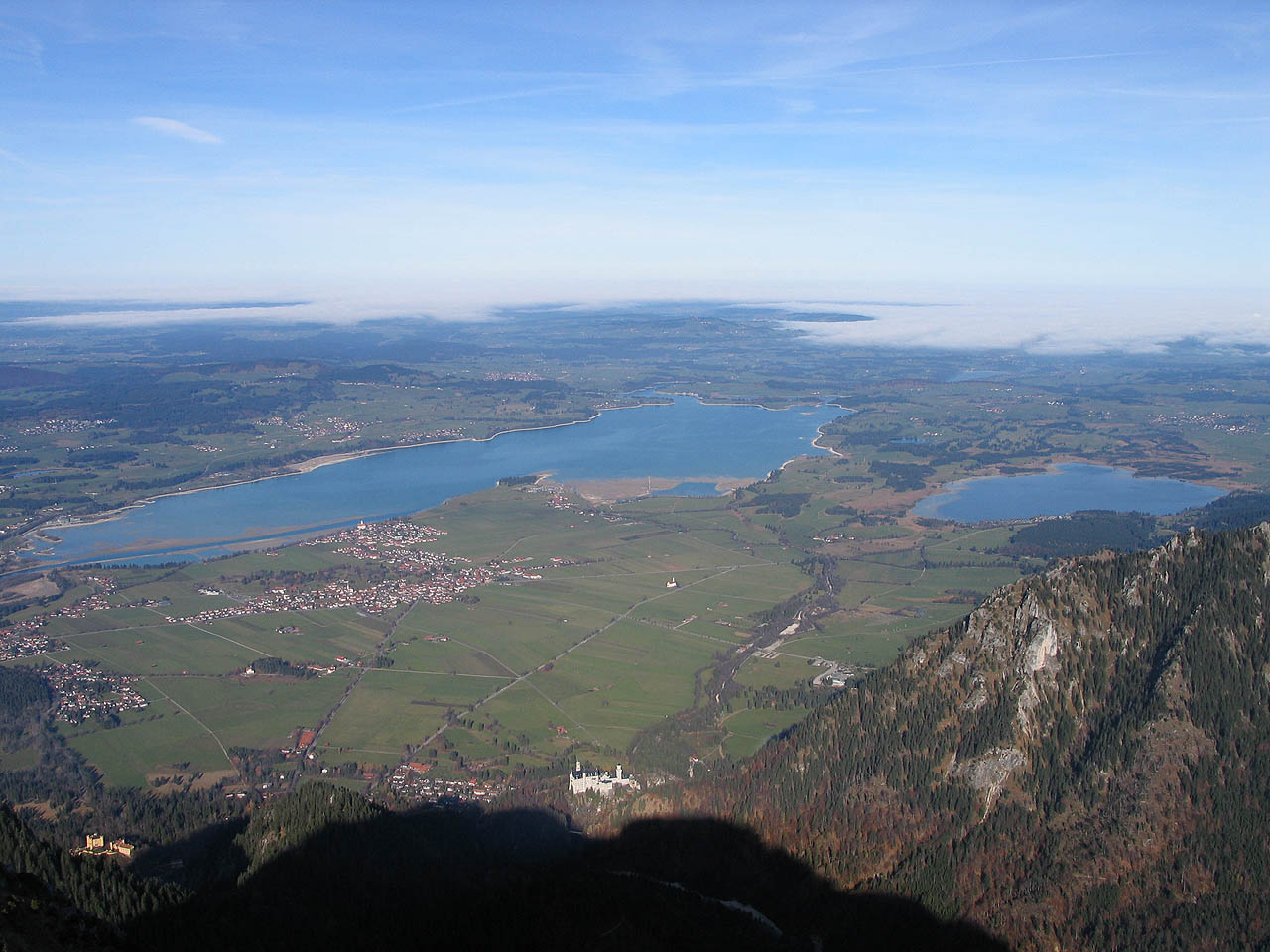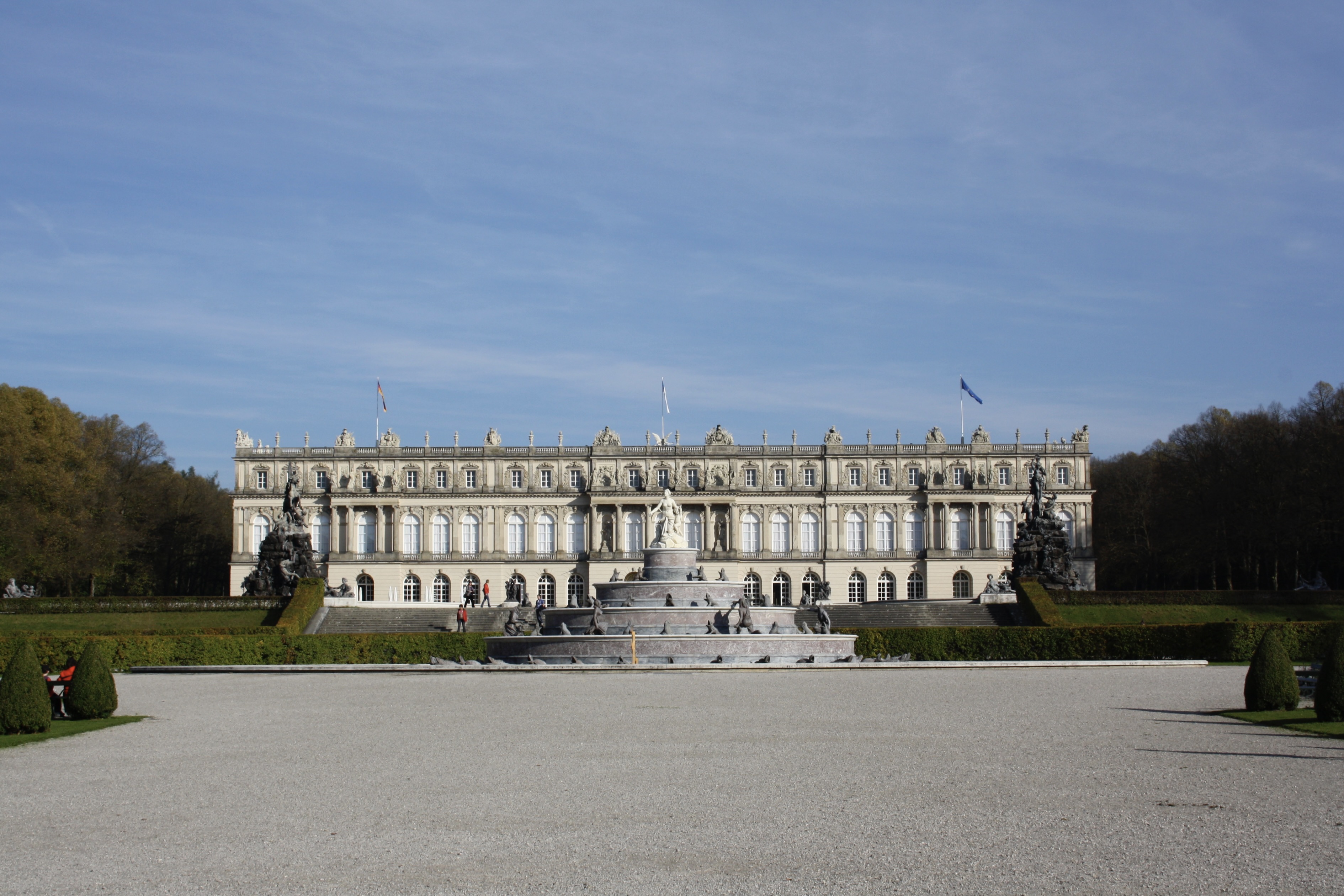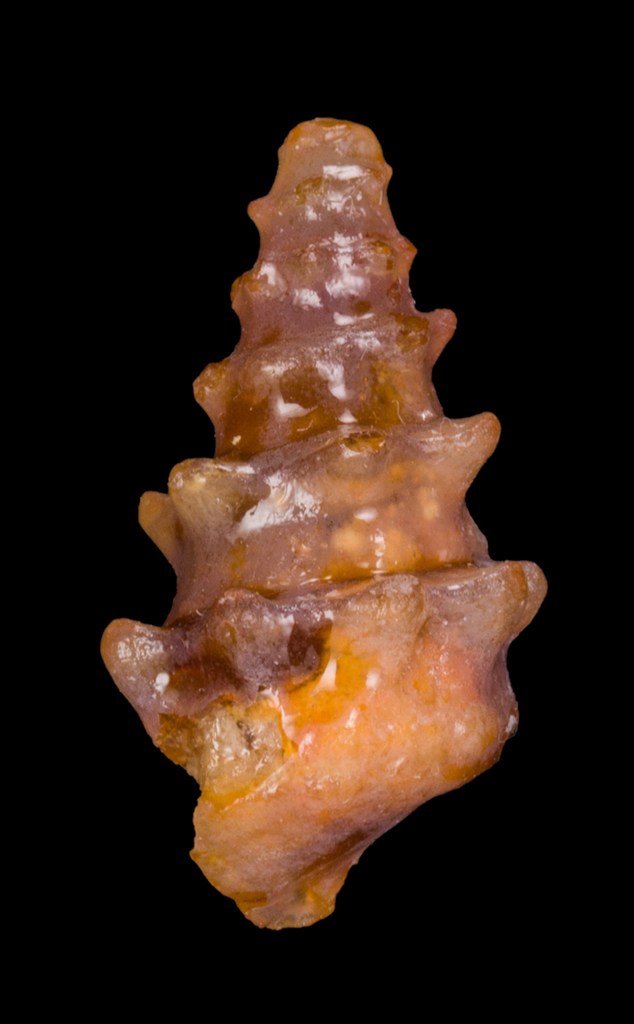|
Linderhof
Linderhof Palace (german: Schloss Linderhof) is a Schloss in Germany, in southwest Bavaria near the village of Ettal. It is the smallest of the three palaces built by King Ludwig II of Bavaria and the only one which he lived to see completed. Development Ludwig already knew the area around Linderhof from his youth when he had accompanied his father King Maximilian II of Bavaria on his hunting trips in the Bavarian Alps. When Ludwig II became King in 1864, he inherited the so-called ''Königshäuschen'' from his father, and in 1869 began enlarging the building. In 1874, he decided to tear down the Königshäuschen and rebuild it on its present-day location in the park. At the same time three new rooms and the staircase were added to the remaining U-shaped complex, and the previous wooden exterior was clad with stone façades. The building was designed in the style of the second rococo-period. Between 1863 and 1886, a total of 8,460,937 marks was spent constructing Linderhof. Symb ... [...More Info...] [...Related Items...] OR: [Wikipedia] [Google] [Baidu] |
Ludwig II Of Bavaria
Ludwig II (Ludwig Otto Friedrich Wilhelm; 25 August 1845 – 13 June 1886) was King of Bavaria from 1864 until his death in 1886. He is sometimes called the Swan King or ('the Fairy Tale King'). He also held the titles of Count Palatine of the Rhine, Duke of Bavaria, Duke of Franconia, and Duke in Swabia. Ludwig ascended to the throne in 1864 at the age of 18. Two years later, Bavaria and History of Austria, Austria fought Austro-Prussian War, a war against Prussia lasting only a matter of weeks, which they lost. However, in the Franco-Prussian War of 1870, Bavaria sided with Prussia in their successful war against France. Despite Ludwig's reluctance to support the Unification of Germany, Bavaria and 21 other monarchies became part of the new German Empire in 1871 (), with Wilhelm I, German Emperor, Wilhelm I, the Monarchy of Germany, King of Prussia and Ludwig's cousin, as the German Emperor (). Bavaria retained a large degree of autonomy within the Empire under the Constituti ... [...More Info...] [...Related Items...] OR: [Wikipedia] [Google] [Baidu] |
Neuschwanstein
Neuschwanstein Castle (german: Schloss Neuschwanstein, , Southern Bavarian: ''Schloss Neischwanstoa'') is a 19th-century historicist palace on a rugged hill above the village of Hohenschwangau near Füssen in southwest Bavaria, Germany. The palace was commissioned by King Ludwig II of Bavaria as a retreat and in honour of Richard Wagner. Ludwig chose to pay for the palace out of his personal fortune and by means of extensive borrowing, rather than Bavarian public funds. Construction began in 1869, but was never fully completed. The castle was intended as a private residence for the King, until he died in 1886. It was open to the public shortly after his death. Since then more than 61 million people have visited Neuschwanstein Castle. More than 1.3 million people visit annually, with as many as 6,000 per day in the summer. Location The municipality of Schwangau lies at an elevation of at the southwest border of the German state of Bavaria. Its surroundings are character ... [...More Info...] [...Related Items...] OR: [Wikipedia] [Google] [Baidu] |
Herrenchiemsee
Herrenchiemsee is a complex of royal buildings on Herreninsel, the largest island in the Chiemsee lake, in southern Bavaria, Germany. Together with the neighbouring isle of Frauenchiemsee and the uninhabited Krautinsel, it forms the municipality of Chiemsee, located about southeast of Munich. The island, formerly the site of an Augustinian monastery, was purchased by King Ludwig II of Bavaria in 1873. The king had the premises converted into a residence, known as the Old Palace (''Altes Schloss''). From 1878 onwards, he had the New Herrenchiemsee Palace (''Neues Schloss'') erected, based on the model of Versailles. It was the largest, but also the last of his building projects, and remained incomplete. Today maintained by the Bavarian Administration of State-Owned Palaces, Gardens and Lakes, Herrenchiemsee is accessible to the public and a major tourist attraction. Old Palace (Herrenchiemsee Abbey) According to tradition, the Benedictine abbey of Herrenchiemsee was establishe ... [...More Info...] [...Related Items...] OR: [Wikipedia] [Google] [Baidu] |
Ettal
Ettal is a German municipality in the district of Garmisch-Partenkirchen, in Bavaria. Geography Ettal is situated in the ''Oberland'' area in the ''Graswangtal'' between the ''Loisachtal'' and '' Ammertal'', approx. 10 km north of Garmisch-Partenkirchen, the district capital, and approx. 4 km southwest of Oberammergau. Division of the town The town consists of 5 districts * Ettal * Graswang * Linderhof * Dickelschwaig * Rahm See also * Ettal Abbey Ettal Abbey (german: Kloster Ettal) is a Benedictine monastery in the village of Ettal close to Oberammergau and Garmisch-Partenkirchen in Bavaria, Germany. With a community (as of 2005) of more than 50 monks, with another five at Wechselburg, th ... References External links Official site Garmisch-Partenkirchen (district) {{GarmischPartenkirchen-geo-stub ... [...More Info...] [...Related Items...] OR: [Wikipedia] [Google] [Baidu] |
Schloss
''Schloss'' (; pl. ''Schlösser''), formerly written ''Schloß'', is the German term for a building similar to a château, palace, or manor house. Related terms appear in several Germanic languages. In the Scandinavian languages, the cognate word ''slot''/''slott'' is normally used for what in English could be either a palace or a castle (instead of words in rarer use such as ''palats''/''palæ'', ''kastell'', or ''borg''). In Dutch, the word ''slot'' is considered to be more archaic. Nowadays, one commonly uses ''paleis'' or ''kasteel''. But in English, the term does not appear, for instance, in the United Kingdom, this type of structure would be known as a stately home or country house. Most ''Schlösser'' were built after the Middle Ages as residences for the nobility, not as true fortresses, although originally, they often were fortified. The usual German term for a true castle is ''burg'', that for a fortress is ''festung'', and — the slightly more archaic term — ''v ... [...More Info...] [...Related Items...] OR: [Wikipedia] [Google] [Baidu] |
Ettal Abbey
Ettal Abbey (german: Kloster Ettal) is a Benedictine monastery in the village of Ettal close to Oberammergau and Garmisch-Partenkirchen in Bavaria, Germany. With a community (as of 2005) of more than 50 monks, with another five at Wechselburg, the Abbey is one of the largest Benedictine houses and is a major attraction for visitors. History Middle Ages and Early Modern period Ettal Abbey was founded on 28 April 1330, Saint Vitalis of Milan's day, by Emperor Ludwig the Bavarian in the Graswang valley, in fulfilment of an vow, on his return from his coronation in Rome, on a site of strategic importance on the primary trade route between Italy and Augsburg. The foundation legend is that Ludwig's horse genuflected three times on the site of the original church building, where a marble statuette of the Madonna and Child ("Frau Stifterin" or the "Ettal Madonna") now stands. The statuette was brought by Ludwig from Pisa as a gift for his new foundation. It soon became an object of pilg ... [...More Info...] [...Related Items...] OR: [Wikipedia] [Google] [Baidu] |
Amethyst
Amethyst is a violet variety of quartz. The name comes from the Koine Greek αμέθυστος ''amethystos'' from α- ''a-'', "not" and μεθύσκω (Ancient Greek) / μεθώ (Modern Greek), "intoxicate", a reference to the belief that the stone protected its owner from drunkenness. Ancient Greeks wore amethyst and carved drinking vessels from it in the belief that it would prevent intoxication. Amethyst, a semiprecious stone, is often used in jewelry and is the traditional birthstone for February. Structure Amethyst is a purple variety of quartz (SiO2) and owes its violet color to irradiation, impurities of iron and in some cases other transition metals, and the presence of other trace elements, which result in complex crystal lattice substitutions.Michael O'Donoghue (2006), ''Gems'', Butterworth-Heinemann, 6th ed. The hardness of the mineral is the same as quartz, thus making it suitable for use in jewelry. Hue and tone Amethyst occurs in primary hues from a li ... [...More Info...] [...Related Items...] OR: [Wikipedia] [Google] [Baidu] |
Louis IV, Holy Roman Emperor
Louis IV (german: Ludwig; 1 April 1282 – 11 October 1347), called the Bavarian, of the house of Wittelsbach, was King of the Romans from 1314, King of Italy from 1327, and Holy Roman Emperor from 1328. Louis' election as king of Germany in 1314 was controversial, as his Habsburg cousin Frederick the Fair was simultaneously elected king by a separate set of electors. Louis defeated Frederick in the Battle of Mühldorf in 1322, and the two eventually reconciled. Louis was opposed and excommunicated by the French Pope John XXII; Louis in turn attempted to depose the pope and install an anti-pope. Louis IV was Duke of Upper Bavaria from 1294 to 1301 together with his elder brother Rudolf I, was Margrave of Brandenburg until 1323, and Count Palatine of the Rhine until 1329, and became Duke of Lower Bavaria in 1340. He was the last Bavarian to be a king of Germany until 1742. He became Count of Hainaut, Holland, Zeeland, and Friesland in 1345 when his wife Margaret inherited ... [...More Info...] [...Related Items...] OR: [Wikipedia] [Google] [Baidu] |
Drawing Room
A drawing room is a room in a house where visitors may be entertained, and an alternative name for a living room. The name is derived from the 16th-century terms withdrawing room and withdrawing chamber, which remained in use through the 17th century, and made their first written appearance in 1642. In a large 16th to early 18th century English house, a withdrawing room was a room to which the owner of the house, his wife, or a distinguished guest who was occupying one of the main apartments in the house could "withdraw" for more privacy. It was often off the great chamber (or the great chamber's descendant, the state room) and usually led to a formal, or "state" bedroom. In modern houses, it may be used as a convenient name for a second or further reception room, but no particular function is associated with the name. History and development In 18th-century London, the royal morning receptions that the French called ''levées'' were called "drawing rooms", with the sense ori ... [...More Info...] [...Related Items...] OR: [Wikipedia] [Google] [Baidu] |
Lapis-lazuli
Lapis lazuli (; ), or lapis for short, is a deep-blue metamorphic rock used as a semi-precious stone that has been prized since antiquity for its intense color. As early as the 7th millennium BC, lapis lazuli was mined in the Sar-i Sang mines,David Bomford and Ashok Roy, ''A Closer Look- Colour'' (2009), National Gallery Company, London, () in Shortugai, and in other mines in Badakhshan province in northeast Afghanistan. Lapis lazuli artifacts, dated to 7570 BC, have been found at Bhirrana, which is the oldest site of Indus Valley civilisation. Lapis was highly valued by the Indus Valley Civilisation (7570–1900 BC). Lapis beads have been found at Neolithic burials in Mehrgarh, the Caucasus, and as far away as Mauritania. It was used in the funeral mask of Tutankhamun (1341–1323 BC). By the end of the Middle Ages, lapis lazuli began to be exported to Europe, where it was ground into powder and made into ultramarine, the finest and most expensive of all blue pigments. Ultr ... [...More Info...] [...Related Items...] OR: [Wikipedia] [Google] [Baidu] |
Germany
Germany,, officially the Federal Republic of Germany, is a country in Central Europe. It is the second most populous country in Europe after Russia, and the most populous member state of the European Union. Germany is situated between the Baltic and North seas to the north, and the Alps to the south; it covers an area of , with a population of almost 84 million within its 16 constituent states. Germany borders Denmark to the north, Poland and the Czech Republic to the east, Austria and Switzerland to the south, and France, Luxembourg, Belgium, and the Netherlands to the west. The nation's capital and most populous city is Berlin and its financial centre is Frankfurt; the largest urban area is the Ruhr. Various Germanic tribes have inhabited the northern parts of modern Germany since classical antiquity. A region named Germania was documented before AD 100. In 962, the Kingdom of Germany formed the bulk of the Holy Roman Empire. During the 16th ce ... [...More Info...] [...Related Items...] OR: [Wikipedia] [Google] [Baidu] |
Chalcedony
Chalcedony ( , or ) is a cryptocrystalline form of silica, composed of very fine intergrowths of quartz and moganite. These are both silica minerals, but they differ in that quartz has a trigonal crystal structure, while moganite is monoclinic. Chalcedony's standard chemical structure (based on the chemical structure of quartz) is SiO2 (silicon dioxide). Chalcedony has a waxy luster, and may be semitransparent or translucent. It can assume a wide range of colors, but those most commonly seen are white to gray, grayish-blue or a shade of brown ranging from pale to nearly black. The color of chalcedony sold commercially is often enhanced by dyeing or heating. The name ''chalcedony'' comes from the Latin ''chalcedonius'' (alternatively spelled ''calchedonius'') and is probably derived from the town of Chalcedon in Turkey. The name appears in Pliny the Elder's ''Naturalis Historia'' as a term for a translucent kind of jaspis. Another reference to a gem by the name of ''khalkedon'' ... [...More Info...] [...Related Items...] OR: [Wikipedia] [Google] [Baidu] |








